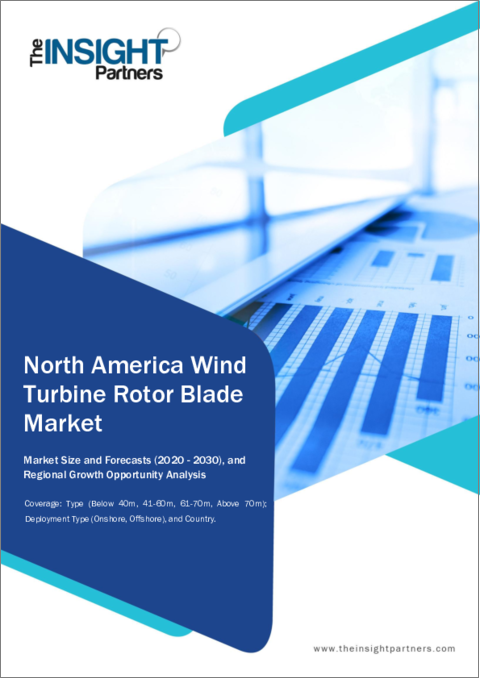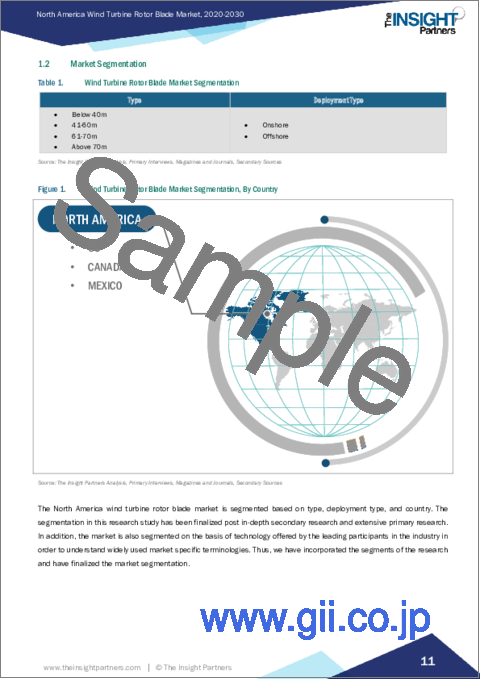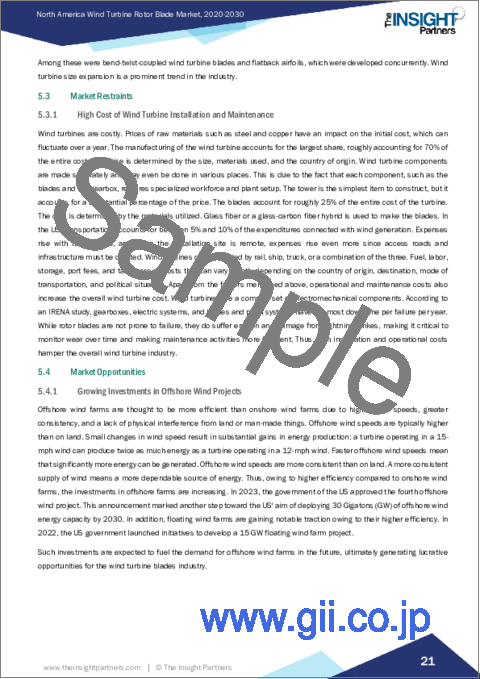|
|
市場調査レポート
商品コード
1510720
北米の風力発電用ローターブレード市場:2030年までの予測、地域別分析 - タイプ別、展開タイプ別North America Wind Turbine Rotor Blade Market Forecast to 2030 - Regional analysis - by Type (Below 40m, 41-60m, 61-70m, and Above 70m) and Deployment Type (Onshore and Offshore) |
||||||
|
|||||||
| 北米の風力発電用ローターブレード市場:2030年までの予測、地域別分析 - タイプ別、展開タイプ別 |
|
出版日: 2024年05月07日
発行: The Insight Partners
ページ情報: 英文 73 Pages
納期: 即納可能
|
全表示
- 概要
- 図表
- 目次
北米の風力発電用ローターブレード市場は、2022年に20億2,251万米ドルと評価され、2030年には45億5,237万米ドルに達すると予測され、2022年から2030年までのCAGRは10.7%で成長すると予測されています。
エネルギー消費の増加とクリーンエネルギーの動向:北米の風力発電用ローターブレード市場
工業化、都市化、人口増加、技術開発などの要因により、エネルギー需要は2000年以降急速に増加しています。IEAの報告書によると、再生可能エネルギーへの投資は、COVID-19パンデミック関連の不況からの回復と世界のエネルギー危機への対応によって大幅に後押しされています。2023年の予測と2021年のデータを比較すると、クリーンエネルギーへの年間投資額は、その間ずっと化石燃料のそれをはるかに上回るペースで増加しています(24%対15%)。世界のエネルギー需要は日々増加しており、その結果、エネルギー危機と炭素排出による環境汚染が起きています。化石燃料に由来するエネルギーは、供給量に限りがあり、枯渇しつつあり、環境に影響を与えるため、持続不可能です。その結果、持続可能でクリーンなエネルギー生産の動向がここ数年で活発化しています。米国、ドイツ、中国など多くの先進諸国がエネルギー危機問題の解決に取り組み、その結果、風力発電産業が発展しました。
米国エネルギー情報局が2022年に発表したデータによると、2021年の米国の一次エネルギー消費量は約98兆英熱量単位(Btu)で、世界の一次エネルギー消費量の約16%を占めました。米国の電力消費は2022年にピークを迎え、4兆500億kWhに達しました。2022年の電力消費量に占める住宅部門の割合は38.9%で、商業部門は35.1%、工業部門は25.8%でした。
政府のデータによると、2022年の再生可能エネルギー発電量は9,000億kWhで、米国全体の発電量の約21%を占めています。
また、IREA(国際再生可能エネルギー機関)によると、風力エネルギーは、研究開発と開発コストの削減により、2000年以降急速に発展しました。こうした要因は、風力発電の開発と設置にプラスの影響を与えています。例えば、世界の陸上風力発電容量は2010年の178GWから2020年には699GWに増加し、洋上風力発電容量は2010年の310GWから2020年には3,440GWに増加しました。さらに、2013年から2022年にかけて、風力エネルギーは世界の再生可能エネルギー投資の32%を集め、その優位性を固め続けた。洋上風力発電への投資も増加し、全体の8%を集めています。このように、人口増加、都市化、工業化、クリーンエネルギーへの嗜好の高まりによる電力需要の増加により、陸上および洋上風力エネルギープロジェクトの需要が増加し、最終的に風力発電用ブレード市場を牽引しています。
北米の風力発電用ローターブレード市場の概要
北米は米国、カナダ、メキシコなどの主要経済圏で構成されています。北米の風力産業は、厳しい政府規制と有利な政策、風力発電プロジェクトへの投資の増加、風力エネルギーのコスト削減により、著しい成長を記録することが期待されています。北米では、持続可能性の目標に対する消費者の意識の高まり、再生可能エネルギーと風力エネルギーの役割により、同地域での風力発電設備の増加が見込まれています。北米は2022年に風力発電設備全体の12%を占め、米国は同地域の新規設備増設の85%以上を占めています。
米国の風力発電は過去5年間で記録的な成長を遂げ、米国の発電容量増加の最大の要因となっています。風力発電は16の州で電力の10%を供給し、アイオワ、カンザス、オクラホマ、サウスダコタ、ノースダコタでは30%以上を供給しています。風力発電技術の性能は、生産税控除や発電コストの低下と相まって、風力発電設備の増設を加速させました。このように、北米における風力発電プロジェクト建設に向けた投資の増加は、風力発電用ローターブレード市場の成長を促進すると予想されます。
北米の風力発電用ローターブレード市場の収益と2030年までの予測(金額)
北米の風力発電用ローターブレード市場のセグメンテーション
北米の風力発電用ローターブレード市場は、タイプ、展開タイプ、国別に区分されます。タイプ別では、北米の風力発電用ローターブレード市場は40m未満、41~60m、61~70m、70m以上に区分されます。2022年には61~70mセグメントが最大の市場シェアを占めています。
展開タイプ別では、北米の風力発電用ローターブレード市場は陸上と海洋に二分されます。2022年の市場シェアは陸上サービスが大きいです。
国別では、北米の風力発電用ローターブレード市場は米国、カナダ、メキシコに区分されます。2022年の北米の風力発電用ローターブレード市場シェアは米国が独占。
TPI Composites Inc、Vestas Wind Systems AS、ENERCON GmbH、LM Wind Power AS、Siemens Gamesa Renewable Energy SA、Acciona SA、Suzlon Energy Ltd、Nordex SE、Envision Energy USA Ltdは、北米の風力発電用ローターブレード市場で事業を展開している大手企業です。
目次
目次
第1章 イントロダクション
第2章 エグゼクティブサマリー
- 主要洞察
- 市場の魅力
第3章 調査手法
- 調査範囲
- 2次調査
- 1次調査
第4章 北米の風力発電用ローターブレード市場情勢
- エコシステム分析
第5章 北米の風力発電用ローターブレード市場:主要産業力学
- 風力発電用ローターブレード市場:主要産業力学
- 市場促進要因
- エネルギー消費の増加とクリーンエネルギーの動向
- グリーンエネルギー生産を促進する政府の取り組み
- 風力発電用ブレード設計の革新
- 市場抑制要因
- 風力発電の設置とメンテナンスの高コスト
- 市場機会
- 洋上風力プロジェクトへの投資の増加
- 今後の動向
- リサイクル技術の採用増加
- 促進要因と抑制要因の影響
第6章 風力発電用ローターブレード市場:北米市場分析
- 風力発電用ローターブレード市場の収益、2022年~2030年
- 風力発電用ローターブレード市場の予測と分析
第7章 北米の風力発電用ローターブレード市場分析:タイプ別
- 風力発電用ローターブレード市場:タイプ別(2022年、2030年)
- 40m以下
- 40m未満市場、収益と2030年までの予測
- 41~60m
- 41~60m市場、収益と2030年までの予測
- 61~70m
- 61~70m市場、収益と2030年までの予測
- 70m以上
- 70m以上の市場、収益と2030年までの予測
第8章 北米の風力発電用ローターブレード市場分析:展開タイプ別
- 風力発電用ローターブレード市場:展開タイプ別(2022年、2030年)
- 陸上
- 陸上市場、収益と2030年までの予測
- オフショア
- オフショア市場、収益と2030年までの予測
第9章 北米の風力発電用ローターブレード市場:国別分析
- 北米
- 米国
- カナダ
- メキシコ
第10章 競合情勢
- 主要企業によるヒートマップ分析
第11章 業界情勢
- 市場イニシアティブ
- 製品開発
- 合併と買収
第12章 企業プロファイル
- TPI Composites Inc
- Vestas Wind Systems AS
- ENERCON GmbH
- LM Wind Power AS
- Siemens Gamesa Renewable Energy SA
- Acciona SA
- Suzlon Energy Ltd
- Nordex SE
- Envision Energy USA Ltd
第13章 付録
List Of Tables
- Table 1. Wind Turbine Rotor Blade Market Segmentation
- Table 2. Wind Turbine Rotor Blade Market Revenue and Forecasts to 2030 (US$ Million)
- Table 3. Wind Turbine Rotor Blade Market Revenue and Forecasts to 2030 (US$ Million) - Type
- Table 4. Wind Turbine Rotor Blade Market Revenue and Forecasts to 2030 (US$ Million) - Deployment Type
- Table 5. US Wind Turbine Rotor Blade Market Revenue and Forecasts to 2030 (US$ Mn) - By Type
- Table 6. US Wind Turbine Rotor Blade Market Revenue and Forecasts to 2030 (US$ Mn) - By Deployment Type
- Table 7. Canada Wind Turbine Rotor Blade Market Revenue and Forecasts to 2030 (US$ Mn) - By Type
- Table 8. Canada Wind Turbine Rotor Blade Market Revenue and Forecasts to 2030 (US$ Mn) - By Deployment Type
- Table 9. Mexico Wind Turbine Rotor Blade Market Revenue and Forecasts to 2030 (US$ Mn) - By Type
- Table 10. Mexico Wind Turbine Rotor Blade Market Revenue and Forecasts to 2030 (US$ Mn) - By Deployment Type
- Table 11. Heat Map Analysis by Key Players
List Of Figures
- Figure 1. Wind Turbine Rotor Blade Market Segmentation, By Country
- Figure 2. Ecosystem: Wind Turbine Rotor Blade Market
- Figure 3. Impact Analysis of Drivers and Restraints
- Figure 4. Wind Turbine Rotor Blade Market Revenue (US$ Million), 2022 - 2030
- Figure 5. Wind Turbine Rotor Blade Market Share (%) - Type, 2022 and 2030
- Figure 6. Below 40m Market Revenue and Forecasts to 2030 (US$ Million)
- Figure 7. 41-60m Market Revenue and Forecasts to 2030 (US$ Million)
- Figure 8. 61-70m Market Revenue and Forecasts to 2030 (US$ Million)
- Figure 9. Above 70m Market Revenue and Forecasts to 2030 (US$ Million)
- Figure 10. Wind Turbine Rotor Blade Market Share (%) - Deployment Type, 2022 and 2030
- Figure 11. Onshore Market Revenue and Forecasts to 2030 (US$ Million)
- Figure 12. Offshore Market Revenue and Forecasts to 2030 (US$ Million)
- Figure 13. Wind Turbine Rotor Blade Market, by Key Countries - Revenue (2022) (US$ Million)
- Figure 14. North America Wind Turbine Rotor Blade Market Breakdown by Country (2022 and 2030)
- Figure 15. US Wind Turbine Rotor Blade Market Revenue and Forecasts to 2030 (US$ Mn)
- Figure 16. Canada Wind Turbine Rotor Blade Market Revenue and Forecasts to 2030 (US$ Mn)
- Figure 17. Mexico Wind Turbine Rotor Blade Market Revenue and Forecasts to 2030 (US$ Mn)
The North America wind turbine rotor blade market was valued at US$ 2,022.51 million in 2022 and is expected to reach US$ 4,552.37 million by 2030; it is estimated to grow at a CAGR of 10.7% from 2022 to 20 30.
Increased Energy Consumption and Trends of Clean Energy North America Wind Turbine Rotor Blade Market.
The demand for energy has rapidly increased since 2000 owing to factors such as industrialization, urbanization, increasing population, and technological developments. As per the IEA's report, investment in renewable energy has been significantly boosted by the rebound from the COVID-19 pandemic-related downturn and the response to the global energy crisis. When comparing projections for 2023 with the data from 2021, annual investment in clean energy has increased far more quickly than that of fossil fuels throughout this time (24% vs. 15%). Global energy demand is increasing every day, resulting in an energy crisis and contamination of the environment due to carbon emissions. Energy derived from fossil fuels is unsustainable due to limited, depleting supply and the environmental impact. As a result, the trends of sustainable and clean energy production increased in the last few years. Many developed countries, such as the US, Germany, and China, took initiatives to solve the energy crisis issues, resulting in the development of the wind turbine industry.
As per the data published by the U.S. Energy Information Administration in 2022, primary energy consumption in the US was approximately 98 quadrillion British thermal units (Btu) in 2021, which accounted for ~16% of the global primary energy consumption. The electricity consumption in the US peaked in 2022, amounting to 4.05 trillion kWh. The residential sector accounted for 38.9% of total electricity consumption in 2022, whereas commercial and industrial accounted for 35.1% and 25.8% of total consumption, respectively.
As per the government data, in 2022, renewable energy sources amounted to 0.9 trillion kWh, which roughly accounted for 21% of the total US electricity generation.
In addition, as per the IREA (International Renewable Energy Agency), wind energy has developed rapidly since 2000, owing to R&D and reduction in developmental costs. Such factors have affected the development and installation of wind power positively. For instance, global onshore wind capacity increased from 178 GW in 2010 to 699 GW in 2020, whereas offshore wind capacity increased from 3.1 GW in 2010 to 34.4 GW in 2020. Moreover, during 2013-2022, wind energy continued to consolidate its dominance, attracting 32% of global renewable energy investments. Investments in offshore wind have picked up, attracting 8% of the total. Thus, with increased demand for electricity owing to growing population, urbanization, industrialization, and increased preferences for clean energy, the demand for onshore and offshore wind energy projects increased, ultimately driving the wind turbine blades market.
North America Wind Turbine Rotor Blade Market Overview
North America constitutes major economies such as the US, Canada, and Mexico. The North American wind industry is expected to register remarkable growth owing to stringent government regulations, favorable policies, increasing investment in wind power projects, and reduced cost of wind energy. In North America, the growing consumer awareness toward sustainability goals and the role of renewable energy and wind energy are expected to increase wind power installations in the region. North America accounted for 12% of total wind power installations in 2022, with the US accounting for more than 85% of new capacity additions in the region.
Wind energy in the US grew at a record growth in the last five years, which represents the largest source of new additions to the US electric-generating capacity. Wind power provides 10% of electricity in 16 states and over 30% in Iowa, Kansas, Oklahoma, South Dakota, and North Dakota. The performance of wind energy technologies, coupled with the production tax credit and lower cost of power generation, accelerated the addition of wind energy capacity. Thus, a rise in investment toward building wind power projects in North America is expected to drive the growth of the wind turbine rotor blade market.
North America wind turbine rotor blade market Revenue and Forecast to 2030 (US$ Million)
North America Wind Turbine Rotor Blade Market Segmentation
The North America wind turbine rotor blade market is segmented based on type, deployment type, and country. Based on type, the North America wind turbine rotor blade market is segmented into Below 40m, 41-60m, 61-70m, and Above 70m . The 61-70m segment held the largest market share in 2022.
In terms of deployment type, the North America wind turbine rotor blade market is bifurcated into onshore and offshore. The onshore services held a larger market share in 2022.
Based on country, the North America wind turbine rotor blade market is segmented into the US, Canada, and Mexico. The US dominated the North America wind turbine rotor blade market share in 2022.
TPI Composites Inc, Vestas Wind Systems AS, ENERCON GmbH, LM Wind Power AS, Siemens Gamesa Renewable Energy SA, Acciona SA, Suzlon Energy Ltd, Nordex SE, and Envision Energy USA Ltd are some of the leading companies operating in the North America wind turbine rotor blade market.
Table Of Contents
Table of Content
1. Introduction
- 1.1 The Insight Partners Research Report Guidance
- 1.2 Market Segmentation
2. Executive Summary
- 2.1 Key Insights
- 2.2 Market Attractiveness
3. Research Methodology
- 3.1 Coverage
- 3.2 Secondary Research
- 3.3 Primary Research
4. North America Wind Turbine Rotor Blade Market Landscape
- 4.1 Overview
- 4.2 Ecosystem Analysis
5. North America Wind Turbine Rotor Blade Market - Key Industry Dynamics
- 5.1 Wind Turbine Rotor Blade Market - Key Industry Dynamics
- 5.2 Market Drivers
- 5.2.1 Increased Energy Consumption and Trends of Clean Energy
- 5.2.2 Government Initiatives to Boost Green Energy Production
- 5.2.3 Innovations in Wind Turbine Blade Designs
- 5.3 Market Restraints
- 5.3.1 High Cost of Wind Turbine Installation and Maintenance
- 5.4 Market Opportunities
- 5.4.1 Growing Investments in Offshore Wind Projects
- 5.5 Future Trends
- 5.5.1 Increasing Adoption of Recycling Technology
- 5.6 Impact of Drivers and Restraints:
6. Wind Turbine Rotor Blade Market - North America Market Analysis
- 6.1 Wind Turbine Rotor Blade Market Revenue (US$ Million), 2022 - 2030
- 6.2 Wind Turbine Rotor Blade Market Forecast and Analysis
7. North America Wind Turbine Rotor Blade Market Analysis -Type
- 7.1 Wind Turbine Rotor Blade Market, By Type (2022 and 2030)
- 7.2 Below 40m
- 7.2.1 Overview
- 7.2.2 Below 40m Market, Revenue and Forecast to 2030 (US$ Million)
- 7.3 41-60m
- 7.3.1 Overview
- 7.3.2 41-60m Market, Revenue and Forecast to 2030 (US$ Million)
- 7.4 61-70m
- 7.4.1 Overview
- 7.4.2 61-70m Market, Revenue and Forecast to 2030 (US$ Million)
- 7.5 Above 70m
- 7.5.1 Overview
- 7.5.2 Above 70m Market, Revenue and Forecast to 2030 (US$ Million)
8. North America Wind Turbine Rotor Blade Market Analysis - Deployment Type
- 8.1 Wind Turbine Rotor Blade Market, By Deployment Type (2022 and 2030)
- 8.2 Onshore
- 8.2.1 Overview
- 8.2.2 Onshore Market, Revenue and Forecast to 2030 (US$ Million)
- 8.3 Offshore
- 8.3.1 Overview
- 8.3.2 Offshore Market, Revenue and Forecast to 2030 (US$ Million)
9. North America Wind Turbine Rotor Blade Market - Country Analysis
- 9.1 North America
- 9.1.1 North America Wind Turbine Rotor Blade Market Overview
- 9.1.2 North America Wind Turbine Rotor Blade Market Revenue and Forecasts and Analysis - By Country
- 9.1.2.1 US Wind Turbine Rotor Blade Market Revenue and Forecasts to 2030 (US$ Mn)
- 9.1.2.1.1 US Wind Turbine Rotor Blade Market Breakdown by Type
- 9.1.2.1.2 US Wind Turbine Rotor Blade Market Breakdown by Deployment Type
- 9.1.2.2 Canada Wind Turbine Rotor Blade Market Revenue and Forecasts to 2030 (US$ Mn)
- 9.1.2.2.1 Canada Wind Turbine Rotor Blade Market Breakdown by Type
- 9.1.2.2.2 Canada Wind Turbine Rotor Blade Market Breakdown by Deployment Type
- 9.1.2.3 Mexico Wind Turbine Rotor Blade Market Revenue and Forecasts to 2030 (US$ Mn)
- 9.1.2.3.1 Mexico Wind Turbine Rotor Blade Market Breakdown by Type
- 9.1.2.3.2 Mexico Wind Turbine Rotor Blade Market Breakdown by Deployment Type
- 9.1.2.1 US Wind Turbine Rotor Blade Market Revenue and Forecasts to 2030 (US$ Mn)
10. Competitive Landscape
- 10.1 Heat Map Analysis by Key Players
11. Industry Landscape
- 11.1 Overview
- 11.2 Market Initiative
- 11.3 Product Development
- 11.4 Mergers & Acquisitions
12. Company Profiles
- 12.1 TPI Composites Inc
- 12.1.1 Key Facts
- 12.1.2 Business Description
- 12.1.3 Products and Services
- 12.1.4 Financial Overview
- 12.1.5 SWOT Analysis
- 12.1.6 Key Developments
- 12.2 Vestas Wind Systems AS
- 12.2.1 Key Facts
- 12.2.2 Business Description
- 12.2.3 Products and Services
- 12.2.4 Financial Overview
- 12.2.5 SWOT Analysis
- 12.2.6 Key Developments
- 12.3 ENERCON GmbH
- 12.3.1 Key Facts
- 12.3.2 Business Description
- 12.3.3 Products and Services
- 12.3.4 Financial Overview
- 12.3.5 SWOT Analysis
- 12.3.6 Key Developments
- 12.4 LM Wind Power AS
- 12.4.1 Key Facts
- 12.4.2 Business Description
- 12.4.3 Products and Services
- 12.4.4 Financial Overview
- 12.4.5 SWOT Analysis
- 12.4.6 Key Developments
- 12.5 Siemens Gamesa Renewable Energy SA
- 12.5.1 Key Facts
- 12.5.2 Business Description
- 12.5.3 Products and Services
- 12.5.4 Financial Overview
- 12.5.5 SWOT Analysis
- 12.5.6 Key Developments
- 12.6 Acciona SA
- 12.6.1 Key Facts
- 12.6.2 Business Description
- 12.6.3 Products and Services
- 12.6.4 Financial Overview
- 12.6.5 SWOT Analysis
- 12.6.6 Key Developments
- 12.7 Suzlon Energy Ltd
- 12.7.1 Key Facts
- 12.7.2 Business Description
- 12.7.3 Products and Services
- 12.7.4 Financial Overview
- 12.7.5 SWOT Analysis
- 12.7.6 Key Developments
- 12.8 Nordex SE
- 12.8.1 Key Facts
- 12.8.2 Business Description
- 12.8.3 Products and Services
- 12.8.4 Financial Overview
- 12.8.5 SWOT Analysis
- 12.8.6 Key Developments
- 12.9 Envision Energy USA Ltd
- 12.9.1 Key Facts
- 12.9.2 Business Description
- 12.9.3 Products and Services
- 12.9.4 Financial Overview
- 12.9.5 SWOT Analysis
- 12.9.6 Key Developments
13. Appendix
- 13.1 About The Insight Partners





